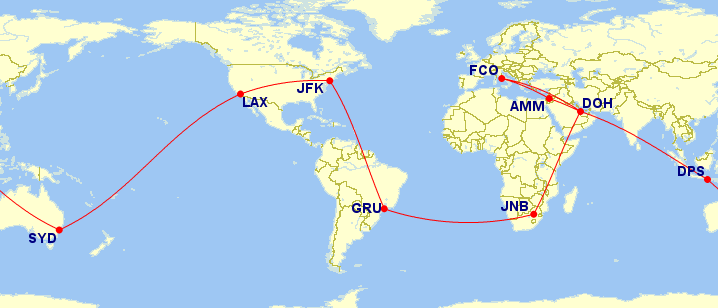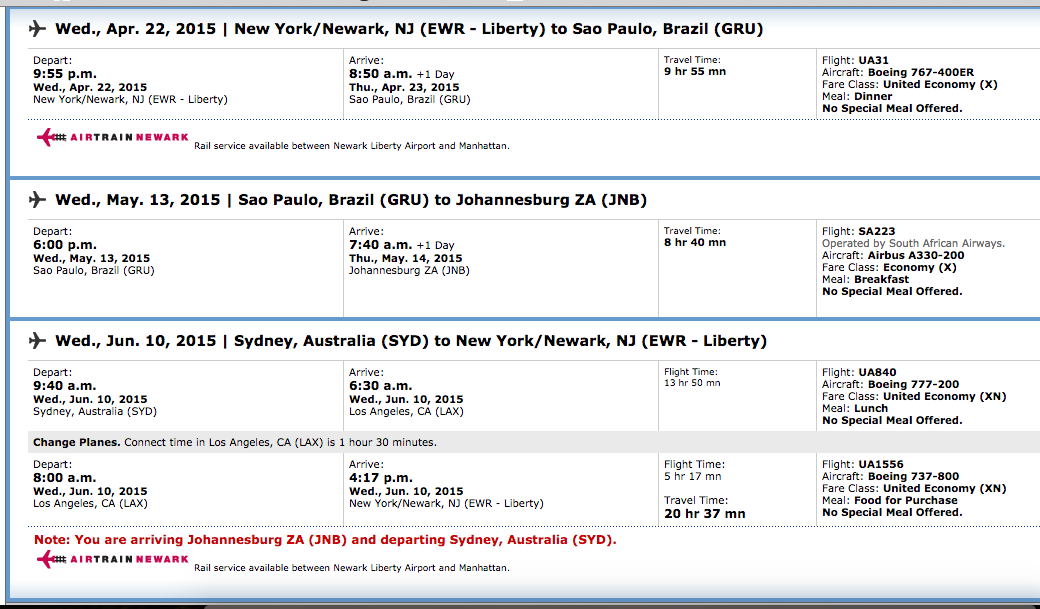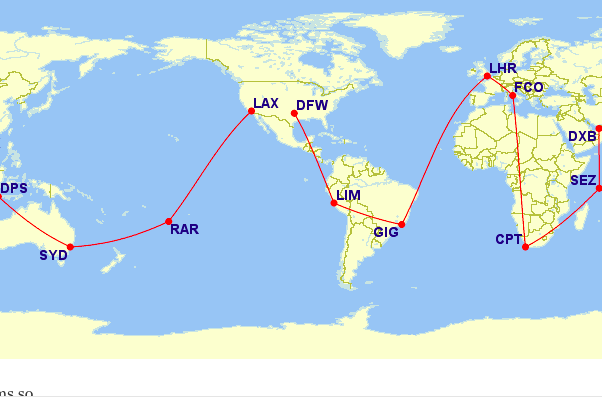 Same rules as last time, but different goal. The goal is to start in the US and see the 5 other inhabited continents: South America, Europe, Africa, Asia, Australia. One of the rules is that I have to use current credit card bonuses, and current award prices.
Same rules as last time, but different goal. The goal is to start in the US and see the 5 other inhabited continents: South America, Europe, Africa, Asia, Australia. One of the rules is that I have to use current credit card bonuses, and current award prices.
Basically, I want to get everywhere by miles, without paying high fuel surcharges, and without needing more transit. I won’t do open-jaws needing land transit (although you could do that if you want).
This is more of an exercise in redeeming miles well, or at least efficiently. To see part 1, click here.
Planning the right cards
This time I’m not even going to bother showing much more of the brain storming map, because I’ll kind of do it as I go.
But part of the way I’ll make it work is by allowing myself to get the United card instead of the Chase Sapphire Preferred. The Sapphire Preferred is a publicly available card, and it seemingly has a higher sign up bonus.
But what I have no doubt is true for anyone, is that you can get a 55,000 mile card.
First step is to transfer 1,000 points from Chase into a United account. If you already have United miles in an account, then you can skip this step. If you don’t have Chase points you’ll need to go ahead and split the sign ups, which is no big deal. So today sign up for Ink Plus and the AA card, and then when you can get the United card do that later. Both Chase cards are worth having and they’re very different, besides the obvious that the Ink is a business card.
And the key is this: After the points have been in your United account long enough you should be able to see the 50,000 mile United card. Here’s the link to check, and remember, you have to be logged in to see the cards: Business Card, Personal Card. But in my experience, they start mailing you offers right away. But for sure within a month you should be able to get the 50,000 mile card, plus it gives 5,000 for adding an authorized user. Basically, 55,000 United miles.
So 50k Ink Plus and the 5,000 points you’d get from meeting the $5,000 spend requirement. The 50k AA card and the 3,000 miles from the $3,000 spend requirement. And then the 55k United card.
Then I could transfer all of my Chase points over to United. Thus, the totals are:
- 110,000 United miles
- 53,000 AA miles
Starting out around the world
Like I said I’m jumping right into it and explaining my logic as I go.
As I’ve stated in the United routing rules, you get one stopover but it has to be on a roundtrip. Then you may also notice United does not allow stopovers to South America on the way to Africa. Well, that’s true sometimes, but the exception is Brazil… for whatever reason.
I’ll eventually show the screenshot to South Africa via Brazil. That’s however long you want in Brazil and then on to Africa.
Here I’ll introduce a concept I have yet to talk much about in regards to United, but it’s how I had to get this trip to work.
Mega Open-Jaws
I’m deciding to call this concept “mega open-jaws”, because that’s exactly what this is.
Remember how according to the Complete Guide of United Routing Rules it states that United allows an open-jaw on the destination? Well, in this case South Africa is the destination and we technically can open-jaw so we continue our flight from somewhere else.
Typically you might use this to do land transit from Cape Town to Johannesburg, but we’re going to take this a step further. In case you’re not familiar with “open-jaws”, it just means that there is a gap in the ticket where the airline isn’t responsible for transportation.
So what I’m going to do here, is create a mega open-jaw from South Africa to Australia. Meaning, I’ll have to leave a big enough time gap, and arrange my own transit to get to Sydney, Australia to continue the ticket.
If you want to see another example of a mega open-jaw, read my post on ANA stopover secrets.
In short, my United ticket will be:
- USA – Sao Paulo – Johannesburg = 40,000 United miles
- Sydney – USA = 40,000 United miles
That’s 80,000 United miles down, and 30,000 to go.
And just a little proof that this is bookable online:

Getting from Africa to Europe, Asia and Sydney:
Remaining:
- 53,000 AA miles
- 30,000 United miles
I’m having trouble making this fit to be honest… My goal is to do Italy, Bali, and then Sydney.
Back to the brain storm map.
- Africa to Europe : 30k United vs 30k AA
- Europe to Asia: 45k-55k United vs 35k AA
- Asia to Australia: 17.5k-20k United (or 12.5k with throw away) vs 25k-30k AA
No matter how I do this… it doesn’t quite fit.
- Middle East to Asia: 22.5k AA
- Europe to Middle East: 10k BA vs 20k AA vs 25k UA
So I’m going to change my mind about that original transfer of Chase points we did to United. Instead of transferring all of them, let’s say we saved 10,000 of those Chase points for British Airways Avios instead of United, meaning our original transfer to United would have been 45,000 points. (Just to be clear, you cannot transfer points back to Chase once you’ve transferred them elsewhere.)
That would leave us with:
- 53,000 AA miles
- 20,000 United miles
- 10,000 BA Avios
Second Attempt
- Africa to Italy = 30,000 AA miles
- Italy to Amman, Jordan = 10,000 Avios
- Jordan to Bali – 22,500 AA miles
- Bali to Sydney = 17,500 United
I’m actually surprised that works. Let me double check the math. Don’t mind if I leave all this in here.
Of the 55,000 Chase points 45,000 went to United for a total of 100,000 United miles, 80,000 of which was used for South America and Africa and also for Sydney back to the US.
The other 10,000 Chase points went to British Airways Avios to get to Amman, Jordan… and after all, Carrie does want to see Petra. That does indeed leave a remaining 20,000 United miles, more than enough for Asia to Sydney.
Then the gaps are South Africa to Italy, and then Jordan to Indonesia.
I was assuming that the flight to Amman was from Rome. So we could fly into Venice or whatever. Anyways that’s 30,000 AA miles, which gives us 23,000 remaining AA miles.
Then the last remaining piece is Jordan to Indonesia, which amazingly will cost 22,500 AA miles. Perfect.
I should clarify that you can really open-jaw any time you are using two different programs. Like I said, you could fly into Europe… anywhere. You could fly into Zurich and then fly out of Rome. But the point here was to do this all on miles.
Also, when using AA miles, do not fly on British Airways, as they pass on fuel surcharges. Use Qatar from South Africa, or really anything else (although your options are often limited when it comes to Africa to BA and Qatar).
Adding it all up:
- USA – Brazil – South Africa = 40,000 United miles (Chase UR transfer)
- South Africa – Italy = 30,000 AA miles
- Italy – Jordan = 10,000 BA Avios (Chase UR transfer)
- Jordan – Indonesia = 22,500 AA miles
- Indonesia – Australia = 17,500 United miles
- Australia – USA = 40,000 United miles (and the same ticket as the first leg to Brazil and South Africa)
That’s 97,500 United miles, 10,000 Avios, and 52,500 AA miles.
Conclusion
Understand that with the exception of the country of Brazil, the rest of the cities could have been basically anywhere in the continent, or at least the region. It didn’t have to be South Africa, it could have been Kenya. It could have been Tanzania.
And it didn’t have to be Italy. It could have been Austria, or the UK, or France.
All that to say, all the miles I used (AA and United) are region based and the destinations were just examples, and the point of this post is to be conceptual.
Similarly, each destination was a legit stop and can be as much or as little time as one would want. You could spend a day in Brazil and a week in Italy. Or you could spend a month in every single destination talked about.
Again with “concepts”, pricing this out was indeed economy, but you could do the same thing with Business class, assuming you have more miles. Or with United, a lot more miles.




Actually transferring back to chase statement is incorrect. I have been able to transfer points from Korean back to Chase. Just a matter of finding the correct department and someone willing to work with you. In my case it took a few weeks but in the end it worked out.
My new favorite concept is the “Mega Open-Jaw”…Thank you for the screen shot proving it’s bookable online. I appreciate that, because it I prefer not having to call and speak to a United Rep. Even if I know the rules, they aren’t always helpful or they give the wrong information.
Thanks for the great post!! My gf is going to be in Europe for a program this summer and I’m trying to plan out credit card apps that will offer the most opportunity for multiple roundtrips to visit her. What would you recommend?
Just left a comment on Carrie’s blog the other day… yall are the BEST. This is such a great post. I love that United.com doesn’t crap out… I just tried a similar route and you would tell it was workin’ real hard, but it did it! 80,000 miles. nice! Long time in “Economy plus” but, worth it. Thank you!
As always BRAVO
Awesome! You are full of great ideas!
There are so many ways to skin that cat..;-)
Seriously keep it coming. This is great inspiration and very few people will use this trick anyhow. Those who will use it will be grateful for this advice!!
USA->S. Africa = 40k UA
Aus->USA = 40k UA
What would happen if one route cost more than the other? Would it just be the total miles? Does that matter?
I used to think that Scott at Milevalue was the best at finding the best uses for miles, but since finding you I’m not so sure anymore. In any case, both of you are phenomenal resources. Thansk for all your research!.
I’m not going to lie; your posts rock. Seriously useful info. Thanks for laying it all out.
Pure gold!! Thanks Drew.
I’ve been trying to figure out how to visit all 6 continents using the fewest miles. If I don’t return to the same region I started in, do I still get the stopover and open jaws? Using United MileagePlus miles, book San Francisco – Barcelona (stopover) – Shanghai (destination), then Sydney – Lima. Each piece would require multiple segments, so I might need to change some destinations if United limits the number of connections. I hope for this to price as US to North Asia (35,000 miles) and Australia to northern South America (45,000 miles).
Then, use United miles for a separate one way from Shanghai to Oceania (15,000 miles), and get off the plane in Sydney. After that, use either Alaska Airlines miles or AAdvantage miles for a one way from Lima to San Francisco, which costs 15,000 miles off-peak. Then, book a Ryanair round trip from Barcelona to Marrakesh, Morocco (as low as $50 round trip), possibly using Barclays Arrival miles.
If that United routing works the way I think it does, then it would add up to 95,000 United miles, 15,000 AAdvantage or Alaska Airlines miles, and about 9,000 Barclays Arrival miles (conservatively assuming $100 round trip for the Ryanair flight). This is 119,000 total miles.
Alternatively, would San Francisco – Barcelona (stopover) – Shanghai (destination) – Oceania MileagePlus redemption work? If it does, then it would price at 50,000 miles (US to North Asia at 35,000 miles, and North Asia to Oceania for 15,000 miles). Or, would San Francisco – Barcelona (stopover) – Shanghai (destination) – Australia work, and price out at 35,000 + 20,000 miles?
Simply the best… !
This was a great demo of how to use miles. As always, much appreciated.
Colleen
I think the RTW challenge should be designing a trip under a certain number of miles (150K, 125K, 100K).
The key city for a low mileage RTW is TLV since it is possible to get a very cheap award to both eastern and western destinations (using different programs). TLV is very handy for exploring Petra as well.
Here is my 100k itinerary. Obviously there are compromises (no Europe or Africa) but hey, it is only 100k! Note that if you want to keep it all under one transfer partner (Chase/UA) the cost would be 112.5K
lax-tlv 25 FB
tlv (or amm)-nrt 22.5 AA
nrt-ksa 12.5 UA
ksa-hnl 25 UA
hnl-lax 15 FB